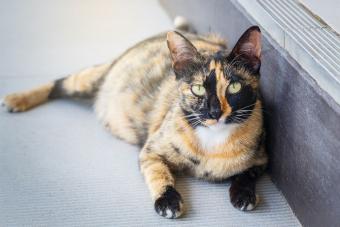
If you've ever gone outside in winter in your warmest coat and still felt a little chilly, then you know how your cat feels. Even though they wear a permanent fur coat, cats can still get cold in the winter. Like their favorite humans, cats want to be warm and cozy (who doesn't?), which is why you may find them snuggled up on the fluffy rug next to the fireplace. You may also notice them cuddling up to you as if you're their personal space heater.
Cats Get Cold, Just Like You
When we talk about our dogs, the common phrase is, "If you're cold, they're cold." This phrase applies to your cat, too. While it's true that their fur gives them a bit of insulation, it doesn't make them immune to cold weather. Indoor cats, in particular, are used to a warm, steady temperature, so the cold may bother them more than your indoor/outdoor kitty.
Remember seeing your cat curled up into a tiny, compact fur ball on a cold day? That's their way of conserving body heat.
Winter Temps Can Be Chilly for Your Cat
Short-haired cats will get cold faster than long-haired cats, but the general guideline is to keep your cat inside if the temperature dips below 45°F (7°C). If you look outside and spot snow flurries, keep kitty inside. You may notice your cat is super finicky about the temperature, hiding in warm nooks and crannies even when it's warmer than 45°F. Your cat's breed, size, age, and health can all affect how tolerant of the cold they are.
Keep an eye out for any signs of discomfort, like excessive shivering or weakness, when the temperature drops.
How to Tell if Your Cat Is Cold
Like dogs, cats are very good at hiding discomfort, but there are some things to check.

- Body check: Touch their ears and paws. If they're noticeably cold, your cat might be cold too.
- Sleeping position: If you see your cat sleeping curled up tight into a ball, especially in a corner or hidden space, they're probably trying to conserve body heat.
- Shivering: This is a clear sign your cat is cold.
- Behavior: If your kitty is more clingy than usual, seeking warmth from you or constantly sitting near heat sources, they might be feeling the cold.
Get Your Cat Ready for Cold Winter Temperatures
Being prepared for cold temperatures can help your fluffy kitty stay comfy all winter long. One of the simplest ways to keep your cat warm is to provide plenty of cozy blankets and beds in their favorite lounging spots. This isn't all you can do to keep your loving furbaby comfortable. There are plenty more things you can do to keep your cat warm all winter long.
- Use a heated pet bed. These beds can provide a steady source of warmth that many cats enjoy. Just make sure to follow all safety instructions.
- Try a cat sweater. While not all cats will tolerate clothing, some will find it comfy. A small sweater could help your cat retain heat.
- Invest in a radiator bed. If your cat is attracted to the warmth of radiators, consider getting a cat-friendly radiator bed.
- Check for drafts. Ensure that your home is free of drafts from windows or doors that could be making your cat cold.
- Provide plenty of high-quality food. Cats burn more energy to stay warm in the winter, so they may need additional calories, particularly species-specific food tailored to their individual needs.
- Keep Your cat inside. If possible, keep your cat indoors during the coldest parts of the day and night.
- Create a cozy shelter. If your cat spends time outdoors, make sure they have a warm shelter to escape from the cold.
- Keep them hydrated. Dehydration can make the cold feel worse, so make sure your cat has access to fresh water at all times.
Remember, every cat is different, so it's essential to pay attention to your cat's behavior and preferences during the colder months to make sure they're comfortable and warm. When in doubt, remember if you're cold, your cat likely is too.
Kittens tend to get cold much faster and may take more time to warm up. Keeping them warm to begin with using these tips is recommended to avoid them becoming too chilly.
Keep Kitty Warm All Winter
Find out what your cat prefers and make the plan to keep them warm based on that. If they're willing to sleep on a cat bed or wear a kitty sweater, those could be good options. If not, find out where they're sleeping and make that area as comfortable as possible. Above all, it's better to be safe than sorry. If you think it's cold or drafty in the house, or your cat wants to go outside but the snow is piling on, it's best to keep them inside.







